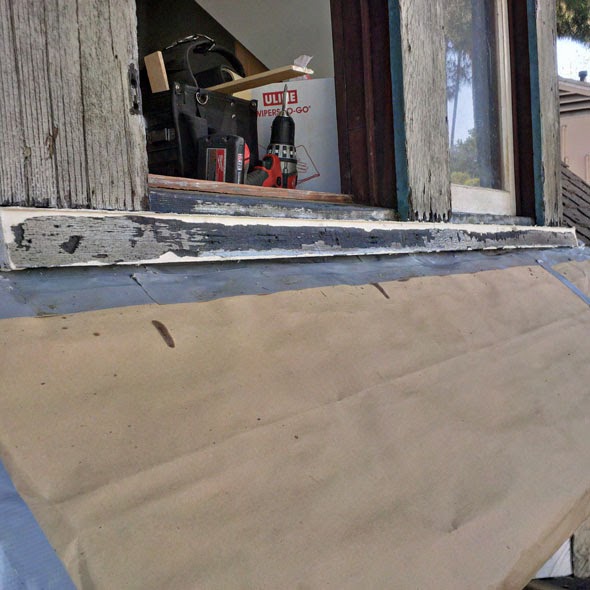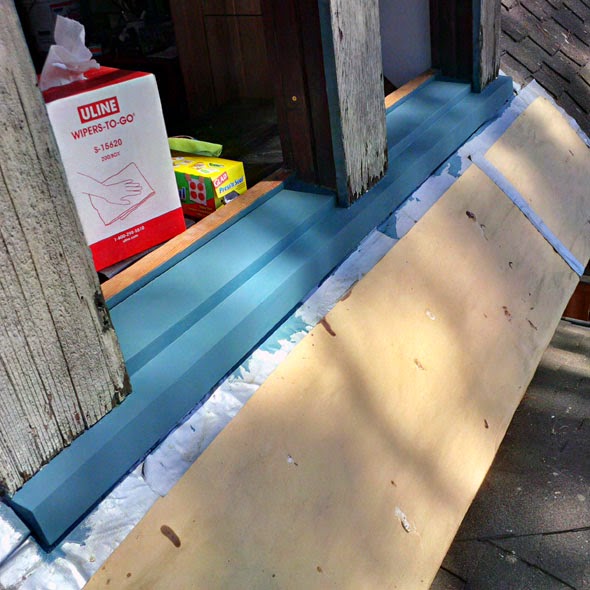Wow, I just found out that the Wayback Machine has been archiving this blog periodically for three years. That's neato! It's good to know that we're being recorded in what is virtually the Official Record of the Intertubes for posterity.
* * *
With the sill work held up while I waited for the fresh WoodEpox to arrive from Abatron, I decided to go on to the refinishing of the sashes, since it was the only other thing I could do easily without the scaffold.
These sashes are the originals, and back when I did the functional rehabilitation I applied an oil-based pigmented stain to the interiors (this was before I had discovered the many virtues of water-based aniline dye stains). This kind of stain provides some protection from the elements even without a more resilient finish over it, and so I didn't have to worry about bleaching out water stains, as I did with the north dormer sashes. In fact, with the exception of some sun-fading and a certain amount of dirt and grime from the environment, the stained interiors looked as good as the day I stained them. A good cleaning and another coat of stain would restore them to varnish-ready condition.
To clean the sash interiors, I used the old Criblecoblis family recipe for wood cleaner: equal parts gum turpentine, boiled linseed oil and white vinegar. I've found that 1/4 cup of each, 3/4 cup total, is a good amount to work with; the mixture works best when it's fresh, and in any event it curdles after a while.
While I find this mixture to have quite a pleasant smell, redolent of the junk shops and antique stores along Honolulu Avenue that I haunted as a lad, it is also rather hard on the sinuses because of the vinegar, so I recommend opening the window when using this stuff.
Here's how to use it: apply to the surface to be cleaned with a paintbrush (I use an inexpensive "chip" brush), using enough to saturate the surface, and agitating the brush as necessary to make sure the cleaner gets in everywhere. Let the cleaner work for a few minutes, then remove it with a terrycloth towel (I use those inexpensive yellow microfiber towels sold at Costco), rubbing gently as necessary to help remove loosened dirt. Repeat as necessary until the surface is clean, then buff with a clean towel to leave an even, soft sheen.
Once the residual turpentine has evaporated from the towels, a hot-water laundering will leave them clean (if perhaps stained from the dirt) and ready to use again. Note that I do not recommend the use of paper towels for this work; the results are decidedly unsatisfactory.
I also don't recommend using this cleaner on unfinished wood; the wood will absorb the oil, changing its color and possibly inhibiting subsequent staining and finishing. To clean unfinished wood, I recommend naphtha or mineral spirits.
This cleaner is effective, but very gentle on finishes. Many cleaners make this claim, but some of them do so fraudulently. Don't ask me how I know. Much of our woodwork here bears the original finish, shellac over a dark pigmented stain. I used this cleaner on all the exposed woodwork in our bedroom as a trial back in 2006. You have to figure that 122-year-old shellac (at that time) would have to be a bit fragile, but the cleaner did not disturb it at all. It removed all the dirt, and left all the shellac.
Some time after I cleaned the exposed wood in the bedroom, I moved the dresser over and put another cabinet in next to it. This has given me a great opportunity to show you what this cleaner does. When I move that cabinet away from the wall, you can see both cleaned and uncleaned wood. After nothing but a dusting, here's a picture of that area:
You can still see clearly the line of demarcation. This not only shows you what this cleaner does, but it shows you that its effects have lasted here for nearly eight years. The sheen has faded, but the wood is still clean, and it still resists soiling.
The cleaned wood still obviously needs work to look good—and to that end, I have some tricks up my sleeve that I can't wait to show you—but the first step in any restoration is always cleaning, and the wood on the left is clean. It will have the same effect on a piece of furniture, with no wax buildup, no static attraction, and no having to do it every time you clean. A table cleaned with this mixture will only need dusting to stay looking clean and polished a long time, until the cat throws up on it or something. Don't ask me how I know.
This cleaner works on painted wood just as well, as long as the paint isn't flat or matte. I even used it on all the old rusty iron hardware, the hinges and the window locks. I brushed it on liberally, and wiped it off conservatively. It removed all the dirt and rust while lubricating the moving parts and leaving the patina. I'm telling you, this stuff is awesome. Just don't try it as a salad dressing. Don't ask me how I know.
One thing I need to add about this cleaner: volatile organic compounds (VOCs) have become increasingly criminalized here in southern California, and as a result most solvents have been reformulated so as to make them as ineffective as possible, so you have to use more of them, thus more VOCs, thus providing the pretext for even more onerous regulations. This includes turpentine. Probably, it will sooner or later include white vinegar as well.
At the same time, boiled linseed oil is no longer boiled; chemicals are added to raw linseed oil to achieve the same effect.
These changes have adversely affected my cleaner. It still works, but it's oilier than it used to be, it refuses to stay mixed for more than a minute, and it goes bad within days instead of weeks. I noticed these problems as I worked, but I didn't figure out the cause until afterwards.
I suspect a partial cure for these problems would involve decreasing the amount of "boiled" linseed oil relative to the other ingredients, say a 4:4:3 ratio, with the oil as the 3. I will experiment and report back, but for now if you use this cleaner, mix it in this new ratio, for example: 1/4 cup each of turpentine and white vinegar with 3 tablespoons boiled linseed oil. Season to taste, then add to salad and toss.
* * *
Despite the unexpected oiliness, the cleaner worked as well as ever on the sash interiors, and after applying another coat of the same stain and waiting several days to ensure that it was thoroughly dry, they were ready to be varnished. However, the fact that the stain was oil-based meant that I could not use the same oil-based varnish that I used on the north dormer sashes. This is because the solvents in the varnish will re-liquefy the stain, causing it to mix unevenly with the varnish, resulting in a mottled, unsightly appearance in the finished wood.
For this reason, I found it necessary to use one of the new waterborne varnishes on these sashes. In the past, a finisher would have used shellac (as did the original Farm House finisher) or lacquer. These, however, are decidedly inferior finishes for a sash, because of its proximity to the elements and the frequency with which a sash is handled and moved in its frame. In this situation, a waterborne varnish is just the thing to use.
The fact that these coatings are called waterborne varnishes, rather than water-based, reflects their utilization of a new, fundamentally different technology. Traditional coatings are held in suspension in a solvent carrier which evaporates, exposing the coating to oxygen which brings about a chemical change, or curing. I don't fully understand how these new coatings work, but as far as I do understand the matter, these are fully cured coatings that are subsequently pulverized and suspended, or borne, in a water-based carrier.
Somehow, when these coatings are applied and the water evaporates, the pulverized varnish cross-links, or re-amalgamates, into a resilient coating that looks and functions like a traditional oil-based resin varnish. It baffles science! Well, actually, science is quite comfortable with it; it only baffles me.
Once I decided to use a waterborne varnish, I looked at all the available options, and selected General Finishes Enduro-Var Gloss, because by all accounts it is the most durable, water-resistant waterborne finish available, and as a plus, it adds an amber cast in emulation of oil-based varnishes.
While I am far from being a professional finisher, I have more than enough experience with varnishes that I am quite confident in my knowledge and abilities. Varnish is just about the most difficult non-specialty coating to apply well, but I've become pretty darn good at brushing out a nice, even coating with no brush marks. But nothing in my experience prepared me for what I saw when I opened up that can:
It looks vaguely disgusting, like that pink slime they add to ground beef. I was even more baffled by the stuff than ever: this is gloss varnish? Well, as I said above, this waterborne varnish is completely different from traditional coatings, so I really shouldn't have been at all surprised to find that it looks completely different.
Or, for that matter, that its application is also different. As a matter of fact, its application is incredibly easy. All you do is spread it out in as thick a coat as possible without runoff, and once you are done with a section, do not go back over it; as the instructions say, if you miss a spot you can get it next time without worry. Because the varnish is so thin, it self-levels magnificently, and because it dries so quickly, dust has almost no time to settle in it.
The result is an astoundingly flawless finish with very little effort and not a whole lot of time. While four coats of traditional varnish takes four days, four coats of this waterborne varnish takes less than a day and a half at a comfortable work pace, and in one long day if you're really in a hurry.

Not that I don't still have some skepticism regarding this new-fangled waterborne stuff. For one thing, while the lack of body in the coating out of the can makes its application so easy that anyone can get professional results, it also gives this varnish very little in the way of build characteristics. Put another way, while there are no irregularities to be seen in the finish itself, every tiny irregularity in the underlying wood is telegraphed right through. Four coats of the traditional oil-based varnish I use, when well applied, gives a surface that is much flatter, with a highly-desirable appearance of depth. A few more coats greatly enhance these properties.
Thus, while this varnish may have the expected resistance to moisture and solvents, and a nice amber cast to boot, still it looks more like lacquer than traditional varnish. This wouldn't be an issue in most situations, but in an old house, it is a bit of a disadvantage.
For another thing, I remain unconvinced that this waterborne varnish will stay looking this good for as long as a traditional oil-based varnish, especially the medium-oil phenolic-resin varnish I use. I suspect that it will not be as UV-resistant. More importantly, it definitely does not have nearly the same resistance to physical damage.
Don't ask me how I know.
* * *
 |
| "Why do they call that hunky guy 'Lassie'?" |
























